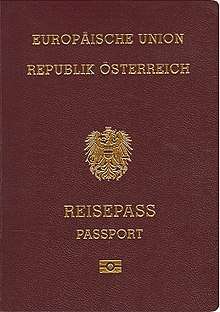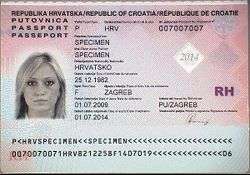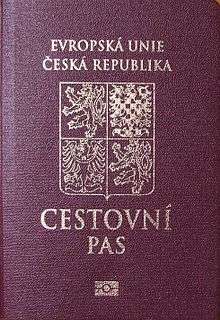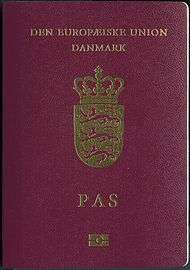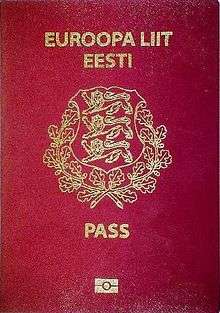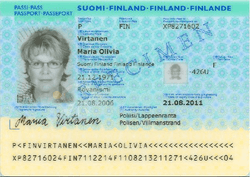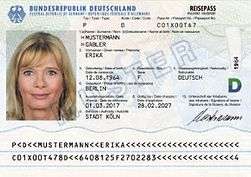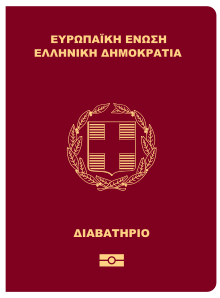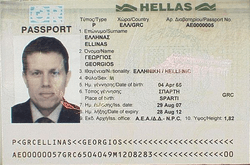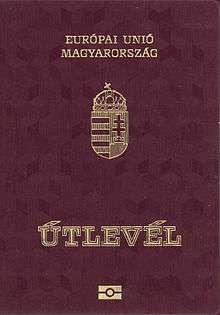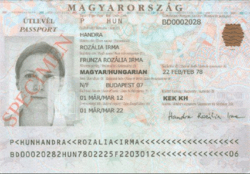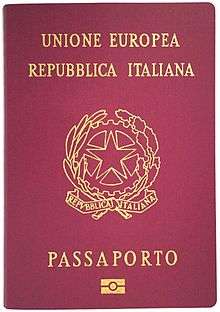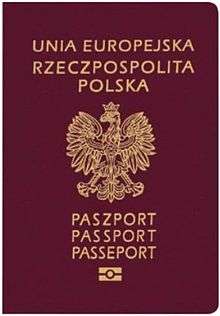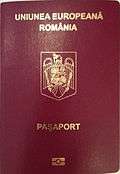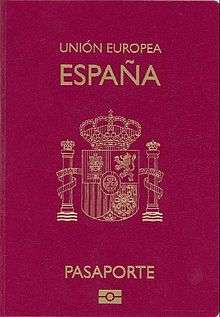Passports of the European Economic Area
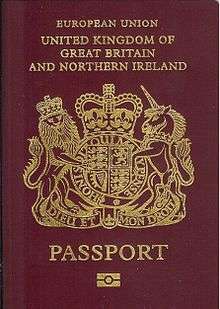
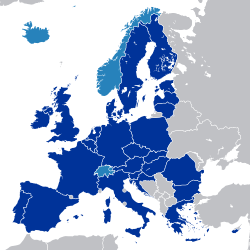
Passports issued by European Economic Area member states (the European Union, plus Iceland, Liechtenstein, and Norway) or Switzerland can be used by citizens to exercise the right of free movement within the European Economic Area and Switzerland.[1]
When going through border controls to enter an EEA country, EEA and Swiss citizens possessing valid biometric passports are sometimes able to use automated gates instead of immigration counters. For example, when entering the United Kingdom, at major airports, adult holders of EEA or Swiss biometric passports can use ePassport gates, whilst all other EEA citizens (such as those using a national identity card or a non-biometric passport) and non-EEA citizens must use an immigration counter. Anyone travelling with children must also use an immigration counter.[2]
As an alternative to holding a passport, EEA or Swiss citizens can also use a valid national identity card to exercise their right of free movement within the EEA and Switzerland.[3] Strictly speaking, it is not necessary for an EEA or Swiss citizen to possess a valid passport or national identity card to enter the EEA or Switzerland. In theory, if an EEA or Swiss citizen outside of both the EEA and Switzerland can prove his/her nationality by any other means (e.g. by presenting an expired passport or national identity card, or a citizenship certificate), he/she must be permitted to enter the EEA or Switzerland. An EEA or Swiss citizen who is unable to demonstrate his/her nationality satisfactorily must nonetheless be given 'every reasonable opportunity' to obtain the necessary documents or to have them delivered within a reasonable period of time.[4][5][6]
Characteristics
Since the 1980s, member states of the European Union have started to harmonise aspects of the designs of their ordinary passports (but not other types of passports, such as diplomatic, service and emergency passports), as well as common security features and biometrics.
Most passports issued by EU member states have the common recommended lay out; burgundy in colour with the words “European Union” accompanied by the name of the issuing member state printed on the cover.[7]
Overall format
- Paper size B7 (ISO/IEC 7810 ID-3, 88 mm × 125 mm)
- 32 pages (passports with more pages can be issued to frequent travellers)
- Colour of cover: burgundy red
Cover
Information on the cover, in this order, in the language(s) of the issuing state:
- The words "EUROPEAN UNION" (before 1997: "EUROPEAN COMMUNITY")
- Name of the issuing state (similar typeface as "EUROPEAN UNION")
- Emblem of the state
- The word "PASSPORT"
- The Biometric Passport symbol:

First page
Information on the first page, in one or more of the languages:
- The words "EUROPEAN UNION"
- Name of the issuing state (similar typeface to that of "European Union")
- The word "PASSPORT"
- Serial number (may also be repeated on the other pages)
Identification page
In passports issued by the EU member states, information on the (possibly laminated) identification page, in the languages of the issuing state plus English and French, are accompanied by numbers that refer to an index that lists the meaning of these fields in all official EU languages. Passports issued in the EFTA member states do not necessarily list such references.
1. Surname 2. Forename(s) 3. Nationality 4. Date of birth 5. Sex 6. Place of birth 7. Date of issue 8. Date of expiry 9. Authority 10. Signature of holder
On the top of the identification page there is the code "P" for passport, the code (ISO 3166-1 alpha-3) for the issuing country, and the passport number. On the left side there is the photo. On other places there might optionally be a national identification number, the height and security features. The layout of the biographical data page shall follow the specifications given in part 1 of ICAO Document 9303.[8]
Machine-readable zone
Passports and travel document shall contain a machine-readable biographical data page, which shall comply with Part 1 (machine-readable passports) of ICAO Document 9303 and the way they are issued shall comply with the specifications for machine-readable passports set out therein.[8] Newer EEA passports contain a Machine-readable zone, which contains the name, nationality and most other information from the identification page. It is designed in a way so that computers can fairly easily read the information, although it still human readable, since it contains only letters (A–Z), digits and "<" as space character, but no bar graph or similar. Apostrophes and similar have to be omitted, but hyphens and spaces should be replaced by an angle bracket. Diacritical marks are not permitted in the MRZ. Even though they may be useful to distinguish names, the use of diacritical marks in the MRZ could confuse machine-reading equipment.
Personal name spelling differences
Names containing non-English letters are usually spelled in the correct way in the non-machine-readable zone of the passport, but are mapped according to the standards of the International Civil Aviation Organization (ICAO) in the machine-readable zone. For example, the German umlauts (ä, ö, ü) and the letter ß are mapped as AE / OE / UE and SS, so Müller becomes MUELLER, Groß becomes GROSS, and Gößmann becomes GOESSMANN.
The ICAO mapping is mostly used for computer-generated and internationally used documents such as air tickets, but sometimes (like in US visas) also simple letters are used (MULLER, GOSSMANN). German credit cards use in their non-machine-readable zone either the correct or the mapped spelling.
Some German names are always spelled with "old" spelling, such as the poet Johann Wolfgang von Goethe or the Third-Reich politician Paul Joseph Goebbels; however, in the name of the German football player Ulrich Hoeneß, the umlaut is spelled "old", but the letter ß is not (the spelling in the machine-readable passport zone is HOENESS, the ß being mapped here).
The three possible spelling variants of the same name (e.g. Müller / Mueller / Muller) in different documents sometimes lead to confusion, and the use of two different spellings within the same document (like in the passports of German-speaking countries) may give people who are unfamiliar with the foreign orthography the impression that the document is a forgery.
The Austrian passport can (but does not always) contain a note in German, English, and French that AE / OE / UE / SS are the common mappings of Ä / Ö / Ü / ß.
Names originally written in a non-Latin writing system may pose another problem if there are various internationally recognized transcription standards. For example, the Russian surname Горбачёв is transcribed
- "Gorbachev" in English,
- "Gorbatschow" in German,
- "Gorbatchev" in French,
- "Gorbachov" in Spanish,
- "Gorbaczow" in Polish, and so on.
The machine-readable zone contains the name transliterated in a standardized (English-based) way, defined by the standard for machine readable travel documents (ICAO 9303). Горбачёв would be written GORBACHEV. There are also tables for the transliteration of names written using Cyrillic and Arabic scripts.
Section 6 of the ICAO document 9303 part 3 specifies transliteration of letters outside the A–Z range. It recommends that diacritical marks on Latin letters A-Z are simply omitted (ç → C, ð → D, ê → E, etc.), but it allows the following transliterations:
å → AA
ä → AE
ð → DH
ij (Dutch letter; capital form: IJ, the J as part of the ligature being capitalized, too)→ IJ
ö → OE
ü → UE (German) or UXX (Spanish)
ñ → NXX
The following transliterations are mandatory:
æ → AE
ø, œ → OE
ß → SS
þ → TH
It is recommended to use the spelling used in the machine-readable passport zone for visas, airline tickets, etc., and to refer to that zone if being questioned. The same thing applies if the name is too long to fit in the airline's ticket system, otherwise problems can arise.[9] (The machine-readable has room for 39 letters for the name while the visual zone can contain as many as will fit)
Following page
Optional information on the following page:
11. Residence 12. Height 13. Colour of eyes 14. Extension of the passport 15. Name at birth (if now using married name or have legally changed names)
Remaining pages
- The following page is reserved for:
- Details concerning the spouse of the holder of the passport (where a family passport is issued)
- Details concerning children accompanying the holder (name, first name, date of birth, sex)
- Photographs of the faces of spouse and children
- The following page is reserved for use by the issuing authorities
- The following page carries the index that translates the field numbers into the official languages of the EU
- The remaining pages are reserved for visa
- The inside back cover is reserved for additional information or recommendations by the issuing state in its own official language(s)
Security features
Passports and travel documents issued by member states shall comply with the minimum security standards, and passports must incorporate a storage medium (a chip) that contains the holder's facial image and fingerprints. This obligation does not apply to identity cards or to temporary passports and travel documents with a validity of one year or less. The United Kingdom and Ireland are not bound by the rules, whereas Iceland, Norway, Switzerland and Lichtenstein are.[8]
Overview of passports
| Member state | Passport cover | Biodata page | Cost | Validity | Issuing authority | Latest version |
|---|---|---|---|---|---|---|
| |
|
|
|
16 June 2006 | ||
| |
|
|
|
|
1 February 2008 | |
| |
 |
|
|
Ministry of Interior Affairs |
29 March 2010 | |
| |
|
|
|
|
|
3 August 2015 |
| |
|
|
|
13 December 2010 | ||
| |
|
|
|
|
|
1 September 2006 |
| |
|
|
|
1 August 2006 | ||
| |
|
|
|
1 June 2014[12] | ||
| |
|
|
|
|
1 January 2017 | |
| |
|
21 August 2012 | ||||
| |
|
|
|
|
28 October 2008 | |
| |
|
|
|
|
Municipal registration office | 1 March 2017 |
| |
|
|
|
|
National Passport Centre ("Διεύθυνση Διαβατηρίων/Αρχηγείο Ελληνικής Αστυνομίας") | 28 August 2006 |
| |
|
|
|
|
Registration Office (Nyilvántartó Hivatal) |
1 March 2012 |
| |
|
|
||||
| |
|
|
Consular and Passport Division of the Department of Foreign Affairs | |||
| |
|
|
|
Minister of Foreign Affairs through | 20 May 2010 | |
| |
 |
 |
|
|
29 January 2015[19] | |
| |
|
|
|
|||
| |
|
|
|
27 January 2011 | ||
| |
|
|
Passport Office, Luxembourg | 1 July 2011 | ||
| |
29 September 2008 | |||||
| |
|
|
|
9 March 2014 | ||
| |
|
|
|
Norwegian Police Service | 1 April 2011 | |
| |
|
|
Application made within Poland:
Application made through a Polish consulate:
In both cases:
|
|
|
1 January 2007 |
| |
|
|
25 May 2009 | |||
| |
|
|
|
|
Ministry of Administration and Interior (General Directorate for Passports) | 26 April 2006 |
| |
|
|
|
15 January 2008 | ||
| |
 |
28 August 2006 | ||||
| |
|
|
|
2 January 2015 | ||
| |
|
|
|
2 January 2012 | ||
| |
|
|
|
1 March 2010 | ||
| |
|
|
|
December 2015 | ||
| |
|
|
|
Civil Status and Registration Office, Gibraltar |
1 EU member state Croatia finished negotiating their accession to the EEA in November 2013, and is since 12 April 2014 provisionally applying the agreement pending its ratification by all EEA countries.
2 EFTA member state Switzerland is not a part of the EEA, but is through a bilateral series of agreements a part of the area in a practical sense.
Visa requirements
Visa requirements for European Economic Area (EEA) and Swiss nationals are administrative entry restrictions by the authorities of other states placed on citizens of the EEA and Switzerland. EEA and Swiss nationals enjoy freedom of movement in the European Economic Area and Switzerland. EEA/Swiss citizens and are not only visa-exempt but are legally entitled to enter and reside in each other's countries. The Citizens’ Rights Directive 2004/38/EC (also sometimes called the "Free Movement Directive") defines the right of free movement for citizens of the EEA, which includes the member states of the EU and the three EFTA members Iceland, Norway and Liechtenstein. Switzerland, which is a member of EFTA but not of the EEA, is not bound by the Directive but rather has a separate bilateral agreement on free movement with the EU.
Passport rankings
Passport rankings by the number of countries and territories their holders could visit without a visa or by obtaining visa on arrival in 2017 were as follows (sourced from Henley visa restrictions index):[24]
By country
For details, click on the name of the country:
- Austria: 173, Belgium: 173, Bulgaria: 154, Croatia: 153, Cyprus: 158
- Czech Republic: 168, Denmark: 174, Estonia: 164, Finland: 174, France: 173
- Germany: 176, Greece: 171, Hungary: 167, Iceland: 169, Ireland: 172
- Italy: 174, Latvia: 165, Liechtenstein: 165, Lithuania: 166, Luxembourg: 173
- Malta: 167, Netherlands: 173, Norway: 173, Poland: 162, Portugal: 171, Romania: 153
- Slovakia: 165, Slovenia: 165, Spain: 174, Sweden: 175, Switzerland: 171, United Kingdom (British Citizen Passport): 173
By rank
|
|
Multiple simultaneous passports
Same country
Some EEA countries, such as Germany, Ireland, Malta, Norway and the UK, allow their citizens to have more than one passport at once to circumvent certain travel restrictions. This can be useful if wanting to travel while a passport remains at a consulate while a visa application is processed, or wanting to apply for further visas while already in a foreign country. It can also be needed to circumvent the fact that visitors whose passports show evidence of a visit to Israel are not allowed to enter Iran, Iraq, Lebanon, Libya, Saudi Arabia, the Sudan, Syria and Yemen (It is, however, possible to get the Israeli entry and exit stamp on a separate piece of paper).
Multiple citizenship
Each EEA member state can make its own citizenship laws, so some countries allow dual or multiple citizenship without any restrictions (e.g. Denmark, Finland, France, Ireland, Iceland, Italy, Sweden, the United Kingdom), some regulate/restrict it (e.g. Austria, Germany, the Netherlands, Spain, Switzerland), and others allow it only in exceptional cases (e.g. Lithuania, Norway) or only for citizens by descent (e.g. Croatia, Estonia, Liechtenstein).
A citizen of an the EEA or Switzerland can live and work in all other EEA countries or Switzerland, (but not necessarily vote or work in sensitive fields, such as government, police, military where citizenship is often required). Non-citizens may not have the same rights to welfare and unemployment benefits like citizens.
See also
- European Economic Area
- European Free Trade Association
- National identity cards in the European Economic Area
- Passports of the European Union
- Schengen Area
- Visa policy of the Schengen Area
- Visa requirements for European Union citizens
References
- ↑ Decision of the EEA Joint Committee No 158/2007 of 7 December 2007 amending Annex V (Free movement of workers) and Annex VIII (Right of establishment) to the EEA Agreement, EUR-Lex. Retrieved 24 November 2015.
- ↑ "Entering the UK - GOV.UK".
- ↑ "Entry clearance basics (entry clearance guidance) - GOV.UK".
- ↑ Article 6.3.2 of the Practical Handbook for Border Guards (C (2006) 5186)
- ↑ Judgement of the European Court of Justice of 17 February 2005, Case C 215/03, Salah Oulane vs. Ministervoor Vreemdelingenzaken en Integratie
- ↑ "UK Border Force Operations Manual: Processing British and EEA Passengers without a valid Passport or Travel Document" (PDF).
- ↑ Anonymous (6 December 2016). "Document security - Migration and Home Affairs - European Commission".
- 1 2 3 "Council Regulation (EC) No 2252/2004 on standards for security features and biometrics in passports and travel documents issued by Member States".
- ↑ Airline 'ban' on long name (The Sun 22 Sep 2008)
- ↑ http://diplomatie.belgium.be/fr/binaries/prijs_Paspoorten_FR_tcm313-122220.pdf
- ↑ "Osobní doklady - Ministerstvo vnitra České republiky".
- ↑ "Estonian citizen's passport".
- ↑ "Service prices 2014". Poliisi.fi. Archived from the original on 16 February 2014. Retrieved 2014-03-10.
- ↑ http://www.poliisi.fi/poliisi/home.nsf/pages/10F984985C574838C225780D00304F72?opendocument
- ↑ "Il Rilascio".
- ↑ "Passaporto per i minori e espatrio".
- ↑ "Passaporto".
- ↑ "PMLP - pr2".
- ↑ DELFI (29 January 2015). "Jaunā parauga Latvijas pilsoņu pases dizainu izstrādājuši PMLP speciālisti un vācu dizaineri".
- ↑ Koninkrijksrelaties, Ministerie van Binnenlandse Zaken en. "Home - Rijksdienst voor Identiteitsgegevens".
- ↑ Haag, Den. "Paspoort en identiteitskaart voor Nederlanders in het buitenland".
- ↑ "Paspoort wordt 10 jaar geldig". Archived from the original on 21 January 2013.
- ↑ "Archived copy". Archived from the original on 7 November 2013. Retrieved 2014-02-10.
- ↑ "Global Ranking - Visa Restriction Index 2017" (PDF). Henley & Partners. Retrieved 14 March 2017.
External links
| Wikimedia Commons has media related to European Free Trade Association. |
| Wikimedia Commons has media related to European passports. |
